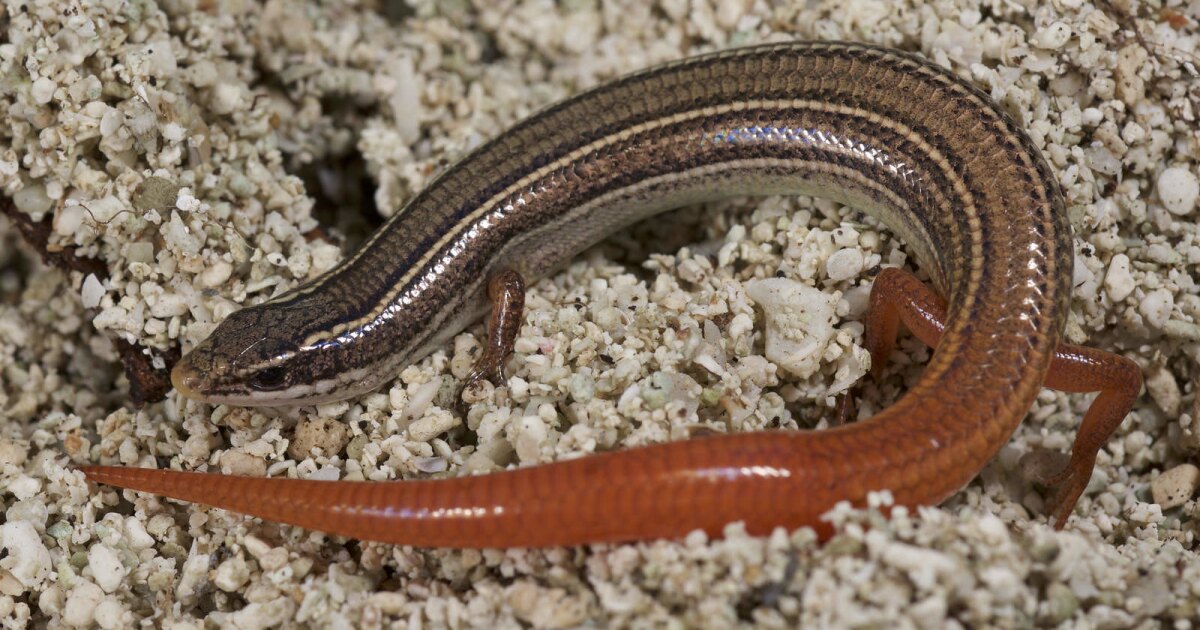
When it comes to endangered animals in Florida, manatees, panthers, Key deer and other charismatic critters tend to win popularity contests and grab the spotlight.
Slithery lizards like the Keys mole skink don’t get license plates.
But conservationists say the mole skink, which lives under rocks and burrows in sand along island beaches, deserves just as much consideration when it comes to protections. Last year, they sued the U.S. Fish and Wildlife Service when the agency refused to add the skink to the endangered species list.
At a federal hearing Thursday, Elise Bennett, a senior attorney with the Center for Biological Diversity, argued the agency both failed to use the latest sea rise data on flooding in making its decision or provide a rational explanation for its decision.
“The skink is unable to move. It's trapped on these islands and these islands are slowly going under water,” she said.
Sea rise is expected to flood half the skink’s habitat by 2060 and three-quarters by 2100. Given the Trump administration’s failure to act on climate change, Bennett said listing the skink now is its only chance of enduring.
In making its decision, the Service relied on 2015 sea rise mapping from the University of Florida to determine flooding, Bennett argued, even while it acknowledged more recent flood projections created by a National Oceanic and Atmospheric Administration climate study in 2016. That study called for 15 to 20 percent more flooding.
“The only explanation that the agency [gave] is that it didn't have shaped files to create maps of what sea level rise looks like,” she said.
The agency dismissed more dire projections for sea rise by 2100, saying models disagreed on how widespread flooding would become. The agency also failed to factor in other threats, Bennett said, from sea rise, storm surge and ongoing development.
Service attorney Mark Brown said the agency needs the maps to determine which keys will flood.
“If we are left with uncertainty or disagreement as to the projected rate of sea level rise and when inundation will occur,” he said, “the decision that listing the skink as a threatened or endangered species is not warranted.”
Instead, he said, the agency can simply revisit the listing when the information is more certain.
Brown also said as islands flood, it’s possible the skinks can “raft” to other islands. Bennett said the agency offered no scientific proof that they could.
The Florida Keys mole skink is one of five subspecies of mole skinks found in just three states, including Florida, Alabama and Georgia. It stands out for its bright red tail - although one species in central Florida has a blue tail - and five-toed floppy feet. The shy Keys skink is the southernmost cousin, found only in the Keys and Dry Tortugas.
Last year, the Trump administration began taking steps to weaken the Endangered Species Act, which has succeeded at halting the extinction of 99 percent of the species added to the list, including the manatee, panther and Key deer. The administration removed blanket protections for threatened species, a lower threshold than endangered, and ruled that damage to threatened species should be decided on a case-by-case basis.
The change also limited the ability of the Service to consider climate change in determining listings. Previously, the agency had to determine if a species would likely become an endangered species within the foreseeable future. An August rule change narrowed the definition of foreseeable future to only as far as the agency can reasonably determine both threats, and the species response, are likely.
It’s a nuanced change, but conservationists say it could deal a big blow to protecting vulnerable species, like beach-dwelling skinks, from long-term hazards like sea rise driven by climate change.
September 07, 2020 at 04:48AM
https://ift.tt/3bC3H9I
Sea Rise Is Threatening To Wipe Out The Keys Mole Skink. Conservationists Want It Protected - WLRN
https://ift.tt/2CoSmg4
Sea
/cloudfront-us-east-2.images.arcpublishing.com/reuters/CZF6NULMVVMEXHOP7JK5BSPQUM.jpg)
No comments:
Post a Comment